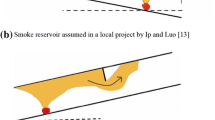Abstract
Results of a full-scale experiment on studying heat transfer on the surface of a reinforced-concrete smoke stack blown by wind at the value of Reynolds number Re = 1.05 × 107 are presented. Comparison of the experimental results with the experimental data obtained previously by other researchers under laboratory conditions at Re < 4 × 106 showed that these data differ essentially from each other in the distribution of local heat transfer coefficients. Factors affecting heat transfer under field conditions are considered together with the possible causes due to which they differ from the factors that take place in laboratory investigations. It should be noted that the values of heat transfer coefficient averaged over the smoke stack generatrix are in satisfactory agreement with the experimental results obtained by extrapolating the data to the region of higher Reynolds numbers for a circular smooth cylinder in a transcritical streamlining mode. The data obtained in the present study open the possibility to estimate the average values of heat transfer coefficient on the surface of smoke stacks in a flow of atmospheric air at 4 × 106 < Re < 107.
Similar content being viewed by others
References
A. P. Maneev, M. I. Nizovtsev, and V. I. Terekhov, “Influence of wind on seepage of gases through the shell of smoke stacks,” Therm. Eng. 60(4), 248 (2013), DOI: 10.1134/S0040363613040061.
E. Achenbach, “Total and local heat transfer from a smooth circular cylinder in cross-flow at high Reynolds number,” Int. J. Heat Mass Transfer 18, 1387–1397 (1975).
A. A. Zhukauskas and I. Zhyugda, Heat Transfer from a Cylinder in Cross Flow of Liquid (Moklas, Vilnius, 1979) [in Russian].
R. M. Fand, “Heat transfer by forced convection from a cylinder to water in crossflow,” Int. J. Heat Mass Transfer 8, 995–1010 (1965).
H. C. Perkins and G. Leppert, “Local heat-transfer coefficients on a uniformly heated cylinder,” Int. J. Heat Mass Transfer 7, 143–158 (1964).
S. Sanitjai and R. J. Goldstein, “Forced convection heat transfer from a circular cylinder in cross flow to air and liquids,” Int. J. Heat Mass Transfer 47, 4795–4805 (2004).
O. A. Gerashchenko, Fundamental of Thermal Measurements (Naukova Dumka, Kyiv, 1971) [in Russian].
G. W. Lowery and R. I. Vachon, “The effect of turbulence on heat transfer from heated cylinders,” Int. J. Heat Mass Transfer 18, 1229–1242 (1975).
A. A. Zhukauskas, Convective Transfer in Heat Exchangers (Nauka, Moscow, 1982) [in Russian].
E. Achenbach, “The effect of surface roughness on the heat transfer from a circular cylinder to the cross flow of air,” Int. J. Heat Mass Transfer 20, 359–369 (1977).
N. E. Kochin, I. A. Kibel’, and N. V. Roze, Theoretical Hydromechanics, Parts 1 and 2 (Gostekhizdat, Moscow, 1948) [in Russian].
J. Kestin and R. T. Wood, “The influence of turbulence on mass transfer from cylinders,” Teploperedacha, No. 4, 1–8 (1971).
M. Wächter, H. Heiβelmann, M. Hölling, A. Morales, P. Milan, T. Mücke, J. Peinke, N. Reinke, and P. Rinn, “The turbulent nature of the atmospheric boundary layer and its impact on the wind energy conversion process,” J. Turbulence 13(26), 121 (2012).
VSN (Departmental Construction Code) 383-77: Instruction for Thermal-Aerodynamic Design of Reinforced-Concrete Smoke Stacks with Backpressure in the Gap between the Shaft and Lining (TsBNTI Minmontazhspetsstroi SSSR, 1979) [in Russian].
Author information
Authors and Affiliations
Corresponding author
Additional information
Original Russian Text © A.P. Maneev, V.I. Terekhov, 2015, published in Teploenergetika.
Rights and permissions
About this article
Cite this article
Maneev, A.P., Terekhov, V.I. Specific features of heat transfer on the external surface of smoke stacks blown by wind. Therm. Eng. 62, 183–189 (2015). https://doi.org/10.1134/S0040601515030064
Published:
Issue Date:
DOI: https://doi.org/10.1134/S0040601515030064




